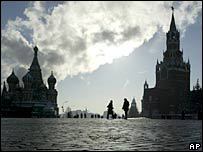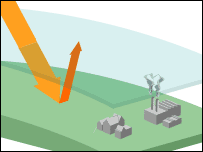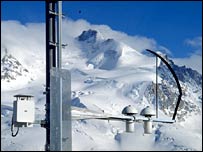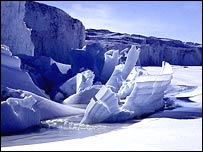|
By Richard Black
Environment Correspondent, BBC News website |
 ''
''There will be some parts of the world affected by strong feedback
and others not ''
Rolf Philipona
|
The scientists say that rising temperatures caused by greenhouse gases are increasing humidity, which in turn amplifies the temperature rise.
This is potentially a positive feedback mechanism which could increase the impact of greenhouse gases such as CO2.
The research is published in the journal Geophysical Research Letters.
The scientists involved have used research networks and weather stations across Europe to measure temperature, humidity and longwave radiation, which plays a key role in the greenhouse effect.
Not from the Sun
"We observed that between 1995 and 2002, the amount of longwave radiation coming downwards to the Earth in Europe increased significantly, whereas solar radiation did not," said study leader Rolf Philipona, from the World Radiation Center in Davos, Switzerland.

|
"We wondered if this effect was simply because of a temperature increase at the surface - you would just get more radiation going up, and so more coming back down," Dr Philipona told the BBC News website.
"But we allowed for this, and for the impact of extra clouds, but still we found an increase."
The researchers calculated that this increase is partly down to higher concentrations of the gases such as carbon dioxide which are often described as causing the "man-made greenhouse effect"; but increased water vapour appears to have a larger effect, accounting for about 70% of the observed temperature rise.
Not all regions of Europe are affected equally.
Between 1995 and 2002, Eastern states appear to have warmed by a rate equivalent to about 2C per decade - considerably faster than their western counterparts.
According to the new study, that may well be down to humidity differences; broadly speaking, humidity has risen fast in the east but not in the west, where evaporation may be limited by the dryness of the Iberian peninsula.
Undervalued water

The ASRB unit at Gornergrat in the Alps measures longwave radiation
|
Because human activities change its concentrations very little, it is generally not mentioned in discussions of modern-day greenhouse warming.
But climate scientists have been aware for decades that mechanisms involving water vapour could amplify temperature increases, and have attempted to model these effects in computer simulations.
Researchers skeptical about projections of human-induced climate change base their criticism partly on what they see as flawed simulations of water vapour and clouds.
So will this discovery force a re-evaluation of climate models? William Ingram, from the UK's Meteorological Office and Oxford University, believes not.
"This careful study confirms that this aspect of the climate system is behaving broadly as expected," he told the BBC News website.
"It is therefore consistent with projections by the scientific consensus."
Local hotspots
|
|

|
"There will be some parts of the world affected by strong feedback and others not - perhaps even a drying in some places," he said.
"We would see that water vapour would go up where there is enough water on the ground."
An increased concentration of water vapour is just one of the feedback mechanisms which could change or amplify the progress of human-induced global warming.
Others include:
- melting of ice, leading to a greater absorption of sunlight
- the conversion of forests from net absorbers of carbon dioxide to net producers
- the release of trapped methane from permafrost.